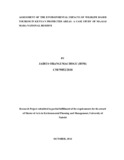| dc.description.abstract | In Kenya, wildlife based tourism accounts greatly towards the growth of Gross Domestic
Product. Tourism is part of a broad conceptual framework formed by a complex
relationship between the nature of tourism development, the consequences of
development in the destination areas, the nature of local development and the
environment external to tourism development. Uncontrolled wildlife based tourism in the
Maasai Mara National Reserve has posed potential threats to its natural areas. It has lead
to enormous pressure on critical natural resource which has lead to impacts such as soil
erosion, increased pollution, discharges into the Mara River, natural habitat loss,
increased pressure on endangered species and heightened vulnerability to biodiversity.
The specific objectives of the study are; to identify the benefits of wildlife based tourism
in Maasai Mara National Reserve, to explore the land use land cover change of Maasai
Mara National Reserve over the last four decades, to examine various negative impacts of
wildlife based tourism in Maasai Mara National Reserve and to discuss the roles of
different stakeholders in mitigating and controlling of impacts of wildlife based tourism
in Maasai Mara National Reserve.
This study was conducted in Maasai Mara National Reserve which is located about 300
Km Northwest of the Kenyan capital, Nairobi in Narok South District, South Rift Valley,
North of Tanzania. The study adopted an exploratory approach using descriptive survey
design to assess the relationship between environmental impacts and wildlife based
tourism activities. Both primary data using respondents’ questionnaires, interview
schedules, observation and photography; and secondary data using study of secondary
information using document analysis and literature review were used for data acquisition.
Also, both qualitative and quantitative data collection and analysis methods like
descriptive of frequencies, percentages, means, and inferential statistics of regression
analysis and chi-square using SPSS version 20 were used to determine the direction of
the respondents’ answers and association between variables. Remotely sensed data of
land use/cover obtained from GLOVIS was analyzed using ArcGis 10.
The findings were presented in Graphs, tables, plates and text. Findings indicated that
Wildlife Based Tourism (WBT) in Maasai Mara National Reserve (MMNR) has both
benefits (including cultural interactions, employment opportunities, infrastructural
development, market for local products and development of tourism facilities) and
negative environmental impacts (human wildlife conflict, loss of vegetation cover, death
and migration of some wildlife animals, destruction of wildlife habitat and disruption of
wildlife’s feeding and breeding patterns). The analysis of remotely sensed maps obtained
from GLOVIS indicates a continuous decrease in vegetation cover between 1975 and
2011. The obtained land-use thematic map illustrates a decreasing forest cover and
increasing grasslands and agricultural land. This reduction in vegetation cover directly
affects biodiversity distribution within the Mara ecosystem which in turn affects WBT.
Key stakeholders were identified as local community, the county government, hospitality
facilities, tourists, tour operators and the government of Kenya through the KWS. These
are the key to causes of negative impacts as they play unique roles in the MMNR. The
major roles include: creating awareness, waste management, offering incentives,
infrastructural developments and implementation of laws governing WBT. The study
recommends increased funding for conservation purposes, regular stakeholder needs
assessment and involvement in conservation programmes implementation and monitoring
through policy formulation. Stakeholders’ participation can also be enhanced through
incentives and education campaigns. | en_US |

